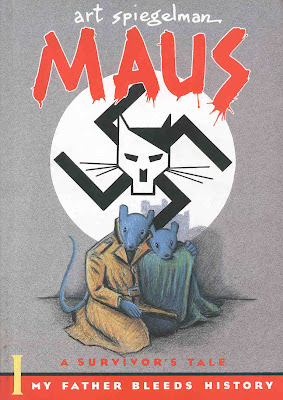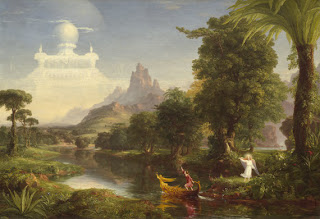
Penny Arcade is known for its refined styles in pencils and coloring.
Yesterday I was listening to episode
#47 of Webcomics Weekly, a podcast hosted by
Brad Guigar,
Dave Kellet,
Scott Kurtz and
Kris Straub, a group of webcomics authors who give their insights on building and maintaing a webcomic business and answer fanmail. In this particular installment, Mike Krahulik of
Penny Arcade, currently the most renowned online comic strip, joins the crew as a special guest, throwing in his opinions on what's worked for him and his business, how he's managed to become so popular, etc.
What really grabbed my attention was a topic that was brought up some time into the episode, where the guys are discussing the roles of writing and drawing a comic, separately from each other as well as cooperatively. Krahulik eventually mentions that some comics, such as
xkcd, utilize very minimal visual art yet implement very intelligent writing.

xkcd uses mere stick figures to draw attention to its dialog.
He continues (in a way that I'm sure wasn't meant to be a slam on the example he gave) to explain his philosophy that comics are a very visual medium, and thus the creator(s)
should aspire to a higher level of art that would require some sort of training or practice to develop, where a certain quality of skill shoud be apparent in the illustrator -- coupled with good writing and storytelling ability.

Chainsawsuit's use of basic line is a commentary on indie comics.
This expression got me thinking. "Should" a comic creator aspire to a polished, more detailed skill in drawings, or is it sometimes sufficient to use stick figures or other simple figures?
When I was a film student at Brigham Young University, I took a documentary production class

Edison's studio housed a locked-down
camera and rotated to control light.
where we discussed a similar question. Bearing in mind the unique capabilities of film and its basic components (sound and a moving image), which is more important to focus on in manipulation of the medium: audio or video? We discussed this quite a bit, and I remember being somewhat torn. Though I seemed to immediately side with the video argument ("What other media exist that utilize a moving picture?"), I couldn't help but remember Thomas Edison who, in spite of all his accomplishments in the invention of the movie camera and
Black Maria, was most pleased with his achievements in audio, more than anything else he had invented. But we had always been told that video should be able to stand alone from the audio in storytelling -- that the viewer should be able to tell what's going on if everything is muted, that music can be

Edison's phonograph.
manipulative and dangerous!
In the end my wise professor calmly stated that BOTH were equally as important. He seemed to take the side of many theorists who believe that any given art medium should focus on and exploit what is exclusive to that specific medium (I don't have my notes from my film theory class with me -- otherwise I'd be able to sound really smart right now and rattle off a few examples). But I'm not sure I entirely agree with that mindset.
It seems to be a pretty purist mindset to tell any medium that it must consider what makes itself that particular medium and equally and fully make use of those aspects in whatever it does. Perhaps I can agree that doing so is to truly make itself representative of the art form, but some of the best films I've ever seen have been more visual than otherwise. Charlie Chaplin continued to make silent films even after the advent of talkies. Did this make him less of a filmmaker? He catered to the strengths of visual storytelling, and was magnificent at it. In fact, in some of his talkies that I've seen, I've found myself wishing that he'd just shut up ("Limelight," anyone?). And the same can be said of the opposite. I've seen films where the audio just blew me away and seemed to say more for the movie than the video did at times (one example being "Dan in Real Life," where I credit the sound mixers and foley artists for making me sense the title character's down-to-earth outlook on the world around him).
Projecting this conversation onto the Krahulik sentiment, I'm not sure I can fully agree that EVERY comic should equally focus on refined writing AND drawing skills.
Firstly, though, I will concede that a worthwhile comic cannot exist without some sort of writing ability. This

Dinosaur Comics reuses the same digital
images and layout in each strip.
doesn't mean that you need to have a Pulitzer, but a comic creator should be able to communicate his or her ideas prettly fluently, however he's going to do it -- whether that be through conventional narrative storytelling, or perhaps an even more mosaic approach where seemingly unrelated images are juxtaposed and clash/merge to convey meaning.
That being said, I question whether or not a refined visual presence is entirely necessary. The beauty of
xkcd is that its simplicity draws the reader to the writing and dialog more. Others, like
Dinosaur Comics, essentially utilize a template of digital images to add text to, showing how the same images can deliver individual stories on a regular basis. Scott McCloud, comics theorist extraordinaire, invented the "
24-hour comic," a challenge to comics creators of every skill level to crank out a comic from conception to finish in a strict 24-hour time period. Take a look at some of the results in the collection on the website. There is some pretty rough artwork in there due to the time limit, but does that make some of them any less a comic than an issue of
Green Lantern?

An excerpt from Scott McCloud's first 24-hour comic, A Day's Work.
There are visual laws that need to be learned when any comic illustrator enters the arena (i.e. telling a visual story, how much space to leave for dialog, layouts, gutter spacing, etc.), but I feel that as long as the artist is consistent in his technique within the given series of comic strips/books and the writing isn't hindered, why not show us new and different ways of visually supporting your writing, even if those ways aren't as seemingly polished as a Davinci?

Is this more a comic than
the likes of xkcd?
What do you think? Are the roles of writing and visual presentation equal in comics? Should a comics creator strive to develop a clean, detailed visual style to support his writing? Discuss!
(In his defense, I am not insinuating that Mike Krahulik would oppose the ideas I raise in this column. He didn't clarify or flesh out his argument enough for me to state that he is against what I have to say -- for all I know he and I could see eye-to-eye on some or most of these points.)

 man who isn't afraid to make his convictions a part of his projects and known to his coworkers.
man who isn't afraid to make his convictions a part of his projects and known to his coworkers.
































